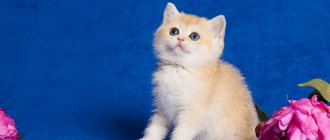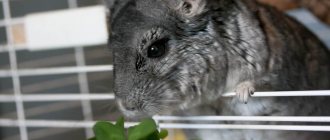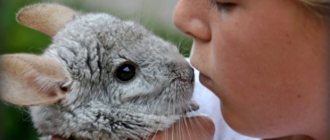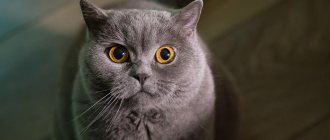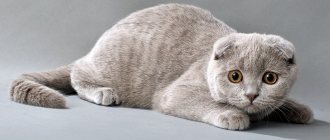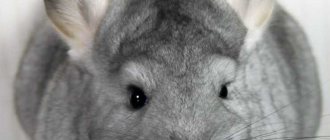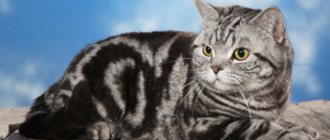The history of the British chinchilla
The history of the origin of British golden chinchillas still causes a lot of controversy. There are several versions of the origin of these animals. According to the first of them, the ancestors of the chinchilla were brought to Britain from Ancient Rome. Followers of this theory are confident that the British are representatives of ancient cat breeds.
However, another part of the researchers is confident that golden chinchilla cats were bred by crossing with other breeds. Such selection work was carried out directly by English researchers. It is believed that the chinchilla owes its thick coat of beautiful color to the crossing of smoky British cats and Persian-colored cats.
This is interesting. Due to the fact that the British chinchilla was created by crossing short-haired and Persian cats, long-haired kittens can be found in the litter. However, the British Longhair cat must meet the same standards as the British Chinchilla.
Gradually, breeders continued crossing, diluting the new breed with the blood of Tabby cats. Experts managed to obtain a golden color using the method described above. But the basis for genetic experiments was no longer Tabby, but a new breed - the magnificent silver chinchilla.
The expectations of specialists were justified, and at the end of the 19th century an animal was obtained that met the golden chinchilla breed standard. These animals were officially recognized only at the end of the 20th century.
History of the breed
British breed cats were bred in England. Although cats were bred by continental Europeans, the animals were named after Great Britain. The name emphasizes the similarity of the color of the cat's fur with the color of the chinchilla.
There are 2 versions of the origin of the British chinchilla. According to one of them, cats were brought to the British Isles by the Romans. This version gives grounds to assert that this breed is one of the most ancient.
According to another version, cats were bred by the British, methodically crossing animals to get the desired result. For mating they used Persian and gray British cats. The breed was officially introduced in 1889.
The first individuals had a gray color, which was called silver color, later golden chinchillas appeared.
Description of the Golden British Chinchilla
The basic characteristics of chinchilla cats correspond to the standards of the British Shorthair cat. The difference between these animals is the length and thickness of the fur; representatives of the first breed.
Appearance
British chinchillas are distinguished by a large, wide chest, strong hips and a straight back. In general, their physique is squat, their muscles are well developed. The weight of cats reaches 5-8 kg, cats 3-4 kg.
The breed standard requires compliance with the following appearance features:
- A rounded head with a wide forehead smoothly transitions into a rounded muzzle with round cheeks.
- The nose is straight, short, with a pinkish nose.
- Small ears, rounded at the ends, set wide apart.
- The neck is muscular and short.
- The round eyes are set shallowly. The ideal eye color for chinchillas is emerald, but yellow and blue shades are acceptable.
- The paws are proportional, muscular, but rather short, and therefore give the impression of being stocky.
- The tail is thick and not too long and ends with a rounded tip.
- The coat is short, thick, and the undercoat is well developed.
There are three main color options for chinchilla cats:
- Silver. Recognized as the most common color of the breed. The belly and chest of cats are almost always white, dark areas are localized on the back, sides and tail.
- Gold. The coat of such cats has a delicate peach tint. These pets are also called the British red chinchilla.
- Shaded silver. Compared to the usual silver color, the animal's fur looks darker. In this case, most of the length of the hairs is shaded, and the undercoat remains white.
This is interesting. Among British chinchillas there are color-point individuals. The colors on the ears, paws and tail of these animals are more “Siamese”, and the color of the eyes is blue.
Character
Golden Britons have a calm disposition. These pets are inactive and do not need constant games and physical activity.
Like all representatives of the cat family, the British have an independent disposition and, at the same time, are attached to their owner. Although chinchillas are affectionate, trusting cats and strive to spend as much time as possible near people, they need a separate place to rest.
Due to the lack of aggression on the part of chinchillas, they are often kept in families with children. These furry creatures almost never hiss and, moreover, do not extend their claws. If a golden cat feels irritated, she will simply move away from the place in which she feels discomfort. Golden chinchillas also get along well with other pets, including dogs or other cats.
For your information. Britons are one of the easiest breeds to train. From the first days of being in the house, this cat adopts the rules of the family in which it happens to live. The pet easily gets accustomed to the tray and scratching post.
Advantages and disadvantages of the breed
The main advantages of the "British"
- the extraordinary beauty of the fur coat. Not only the golden chinchilla is beautiful, but also the British silver chinchilla cat. Their main treasure is large, round-shaped eyes at a small distance from each other. Dark-colored eyeliners add a certain charm to beautiful, expressive eyes;
- good health inherited from parents;
- lack of aggression and kind attitude towards children;
- tolerate loneliness well;
- the kitten is easily toilet trained;
- do not scratch things in the house;
- Do not bother the owner with loud meows. Even a kitten patiently waits for its owner to wake up and does not wake him up in the morning;
- with high intelligence;
- coexists well with animals;
- unpretentious.
Disadvantages of the breed
- the need for early education;
- independence and stubbornness;
- frequent tearing;
- They don’t like to be cuddled or be held.
Contents of a gold Briton
Golden cats of the British breed are suitable for keeping both in a private house and in an apartment. Due to the peculiarities of the coat, shedding in representatives of this breed is almost unnoticeable, especially if it is combed in a timely manner.
Nutrition
Chinchillas can be fed prepared food or natural food.
Important! Under no circumstances should you mix natural food and prepared food. The same prohibition applies to several types of food.
When choosing a dry diet, it is better to focus on super premium or premium classes. Some manufacturers produce lines of food designed specifically for representatives of British breeds, taking into account their needs.
If the owner opted for a natural diet, it should include products such as:
- Raw meat (better lean: veal, turkey). Before serving, it should be placed in the freezer for 12 hours, then doused with boiling water to disinfect it.
- Offal (liver, lungs) boiled or steamed.
- Boiled fish (without bones).
- Low-fat fermented milk products.
- Eggs (preferably quail), 2 times a week.
- Cereals (rice, buckwheat, etc.).
- Vegetables.
The following should be excluded from your pet's diet:
- smoked meats, sausages;
- canned food;
- salty, spicy foods;
- raw milk.
Chinchillas' diet must be balanced. If the animal prefers natural food, vitamin complexes should be added to it from time to time. Drinking water should always be located near the food bowl . It should be changed daily.
How many times a day should you feed your cat?
Chinchillas are prone to overeating and subsequent obesity.
These animals do not know moderation in food, and therefore the dose of delicacy offered to them should be accurately measured. If we are talking about dry food, its quantity must correspond to the data in the table on the package. The amount of natural food is calculated based on the weight and activity of the pet. Leftovers left uneaten by the animal are immediately removed from the bowl. Small kittens eat 6 times a day. Gradually, the number of feedings is reduced, and the animals switch to the feeding regime of an adult cat. The latter are fed 2-3 times a day in small portions.
Walks
The number and duration of promenades depends on the cat's temperament. Some golden pets are content to stay indoors; they are not at all drawn to the street. And other four-legged animals are not at all averse to getting to know the world outside the home.
A chinchilla should be walked on a leash. Before going for a walk, you should take care to protect your animal from parasites. Collars, drops and other means are suitable for this purpose.
Toilet
The golden British chinchilla visits a tray of any size and capacity. Since animals are quite impressive in size, it is better to choose a stable and large toilet for them. Any filler can be used.
Advice. When training a kitten to use the toilet, at first you should purchase the litter that the baby is accustomed to in the nursery. A conscientious breeder, when transferring the baby to a new owner, will provide the latter with all the necessary information.
Description of the chinchilla cat breed
Outwardly, these animals are attractive - a round-shaped muzzle, a neat heart-shaped nose, large and expressive green eyes. Representatives of this breed have fluffy, thick hair, and its color is dark at the base and light at the tips. It seems that it shimmers with a silver or golden color, as if it is shimmering. This effect is called "veil". The breed is also distinguished by the following characteristics:
- A chinchilla cat can be large – weighing up to 7 kg, and a cat of this breed – up to 4 kg.
- Animals have a proportional body, but the illusion can be created that their legs are short compared to their body. This visual effect occurs due to the thick long hair on them.
- The pride of a chinchilla cat is its bushy tail, the hair on which is approximately 1.5 cm longer than on the body.
- If you are interested in whether a chinchilla cat is hypoallergenic or not, then you should know that representatives of this breed do not cause problems for allergy sufferers.
History of the chinchilla cat breed
The birthplace of this breed is America, where in 1880 the first kitten with the original silver-smoky coloring was accidentally born. Breeders could not resist the idea of artificially breeding a breed with this color. To obtain beautiful colors in kittens, felines were crossed with Persian or British cats. The idea of the breeders to combine these breeds with green-eyed tabbies, and the offspring of the first generation with “Persians” brought the desired result. The chinchilla cat as a breed was formed in the 80s of the 20th century.
Chinchilla cat - character
It will be interesting to figure out what owners can expect from a pet of this breed:
- He is inquisitive, playful and restless. It will be easier for owners who have the same character traits to make friends with him. If a pet does not receive support in its interests and fun, there is a risk that laziness, lethargy and apathy will become its companions.
- The golden chinchilla is a cat with a patient character, so she will make friends with children in her owners’ house, but she will not allow herself to be offended.
- The animal, affectionate towards people, does not tolerate competition, living in the same territory with other felines. Having noticed that the “enemy” plans to take a leading position, the chinchilla cat will show who is boss.
- The British representative of this breed will delight his owners with his intelligence and intelligence.
- The chinchilla cat is sensitive to its personal space. She will allow herself to be stroked, but pinching, tight hugs and other intense manifestations of the owner's affection will be suppressed.
- Don't be surprised if your pet acts proudly. Intuitively, he understands how beautiful he is, so he has the right to emphasize his dignity.
- The chinchilla cat skillfully plays with intonations, pronouncing “meow” and “mur”, and therefore the “interlocutor” is understanding and understandable.
How long does a chinchilla cat live?
The lifespan of a pet largely depends on how well it is cared for. The chinchilla cat breed is an animal that can delight its owners for many years with its playful disposition if it is properly maintained. On average, their lifespan is 11-15 years, but many factors influence this indicator:
- Genetics
. - Nutrition
. - Body structure
. The smaller the animal, the greater its chances of joining the ranks of long-livers. There is no need to allow a chinchilla cat to become obese - it causes problems with the heart, stomach, and liver, reducing life expectancy. - Diseases
. Timely veterinary care and disease prevention will help extend the life of a pet.
Appearance care
Complete care for the appearance of a British chinchilla consists of several activities that should be carried out strictly.
Combing
The coat of golden chinchillas includes guard hair and undercoat. Such a multi-level cover needs careful care. Combing is carried out first in the direction of hair growth, and then against the grain. This procedure is performed twice a week, using a special glove or a fine-toothed comb.
Bathing
Despite the fact that the coat of golden chinchillas is quite light, it does not get dirty very often. Therefore, there is no need to bathe your pet often - once every 3 months is enough.
For washing, special shampoos and softening conditioners are used. If there is an urgent need, you can use dry products for washing cat fur, which are selected taking into account the color of the pet.
Ear care
Chinchillas' hearing organs should be carefully examined every 2 weeks. Ear care involves removing dirt and dark plaque using cotton wool. The latter should be moistened with a special composition intended for caring for the ears of cats.
Eye care
The visual organs of British chinchillas require careful care, as they tend to bleed profusely. This process is explained by the original structure of the animal’s tear ducts.
Pets' eyes should be examined regularly to prevent clots from accumulating in the corners. Every morning, the animal’s eyes are wiped with a cotton pad soaked in a solution of boric acid, warm boiled water or a decoction of herbs.
If suppuration is observed, it is permissible to use tetracycline ointment. Progressive eye pathologies require immediate attention to a veterinarian.
Nail care
The claws of golden cats are trimmed once every 2-3 weeks, using special scissors called nail clippers. The pet can remove keratinized particles themselves using a scratching post installed in the room. The latter must be stable and securely fastened.
Dental care
To prevent possible problems with the Briton’s gums and teeth, his oral cavity should be treated once a week. A soft, flexible brush and toothpaste that does not require rinsing are suitable for this purpose.
Bathing
These cats don't like to swim. To keep the coat in good condition, British chinchillas are treated with dry shampoo. The composition is applied to the wool, rubbed in, then combed out with a brush. The powder removes dust, cares for hair, and creates volume. The procedure is performed 2 times a year. Shampoo is selected depending on the shade of the coat. A golden chinchilla will not benefit from a product intended for a pet with silver fur.
British chinchillas do not tolerate regular bathing well. If it is not possible to use dry shampoo, be prepared for a negative reaction from your pet to water. To create maximum comfort, a cloth is placed under the cat's paws. The animal clings to the lining with its claws, does not slip and feels more calm.
When bathing your Briton, make sure that the shampoo does not get into the eyes and ears.
Purchasing a British Golden Chinchilla kitten
Purchasing purebred British chinchilla kittens is not easy. It is better to choose purebred representatives in trusted nurseries or by contacting reliable breeders who breed this particular breed.
Attention! When purchasing an animal on the market or through a private advertisement, there is a high risk of being deceived and becoming the owner of an ordinary kitten with an unusual color.
Criterias of choice
When choosing a British chinchilla kitten, you should consider a number of recommendations:
- Carefully study the breed standard.
- Make a list of breeders and nurseries. Study reviews about them, become familiar with the peculiarities of keeping animals.
- Be sure to look at the kittens' parents, taking into account their compliance with the breed standard. The breeder will certainly provide a pedigree confirming the purebred of the sires up to the 4th generation.
The immediate choice of a kitten should be approached by paying attention to some features:
- Behavior. When a kitten sees a stranger, it should not try to hide in a corner in horror. A healthy baby is cheerful and inquisitive.
- Appearance. The kittens' coat should be shiny, their eyes and ears should be clean, and their nose should be moist.
- Relevant documents: metrics, pedigree, veterinary book, etc.
At what age is it better to adopt a kitten?
Conscientious breeders hand over kittens to new owners no earlier than 3 months . Babies of this age can already feed themselves and are also trained to use a tray.
Chinchilla cat – color
The first representatives of this breed were too dark in color compared to their modern descendants. A common white chinchilla cat is the fur of which is dark at the tips. Animals of this breed are divided into two groups:
- Shaded
- chinchilla cats, a third of whose fur is dark in color. - Shaded
are representatives of the breed that have a dark color on an eighth of their coat. Such chinchilla cats are lighter than shaded animals, whose tail, paws, and ears are more saturated in color.
Golden cat chinchilla
The ancestors passed on to the representative of the breed of this color not only a luxurious appearance, but also nobility, meekness, affection and a certain pride. A distinctive feature of the animal is its color. The golden chinchilla cat has fur, the color of which is characterized by a pronounced transition from light peach down to black tips of the hairs. The shaded appearance of the golden chinchilla cat is most pronounced on the sides and back.
Silver chinchilla cat
Nature has endowed these beauties with a unique coat color and an easy-going, affectionate character. The silver chinchilla cat has large turquoise-emerald eyes and dark paw pads that contrast perfectly with its stunning coat of color. The nose and organs of vision of the animal are outlined in dark. These beauties received this pigment as one of the main genes from their ancestors. It also provides the silver color of the animal.
Breed defects
British chinchillas are not very sick animals, their health is strong. However, genetic diseases that appear as a result of inbreeding are typical for the breed.
Tendency to diseases
British Chinchilla cats may be susceptible to certain diseases, including:
- Retinal atrophy. It is considered a hereditary pathology and can cause decreased vision or loss of vision.
- Polycystic kidney disease. A hereditary disease accompanied by the formation of fluid cysts. At the same time, the quality of blood purification deteriorates, which can provoke intoxication, sepsis and death.
- Hypertrophied cardiomyopathy. Hereditary pathology of the cardiovascular system. Can lead to blockage of blood vessels, pulmonary edema and death of the animal.
You can avoid purchasing a pet with genetic abnormalities by contacting a trusted breeder. At the first alarming symptoms, the cat should be immediately shown to a veterinarian.
Defects in appearance
The following are recognized as serious defects in the appearance of chinchillas:
- thin, sunken cheeks;
- obvious depression on the nose;
- sparse or excessively soft wool;
- high-set ears;
- excessively elongated muzzle;
- flat forehead.
Some shortcomings exclude the British from participating in the competition. These include:
- skeletal deformities;
- deafness;
- blindness;
- anomalies of the eyelids, teeth, jaws.
For your information. Chinchilla coloring has a number of nuances, and certain requirements are imposed on it. Only a specialist can understand the intricacies of animal coloring.
Breeding the British Chinchilla breed
Breeding British chinchillas is quite a complex matter. For this reason, it is recommended that only experienced breeders engage in it.
Criteria for choosing a partner
Finding a suitable pair for a chinchilla is quite problematic due to the small number of the breed. The offspring are characterized by deviations in color, and therefore crossing is carried out by a limited number of individuals and only among the chinchilla variety.
A potential mating partner must meet certain criteria:
- absence of gene pathologies;
- availability of the necessary documents: veterinary passport, pedigree, breeding permit, etc.;
- deworming, vaccination (must be carried out 2-3 weeks before mating).
The chosen "groom" or "bride" must correspond to the characteristics of the breed, especially with regard to coloration.
At what age should you give your pet for the first mating?
British chinchillas reach sexual maturity late. In view of this, mating should begin when the pet is 20-24 months old. Excessively early birth will not have the best effect on the cat’s immature body. In addition, the offspring in this case often turns out to be weak or non-viable.
Color
Experts note 3 main types of chinchilla color:
- golden;
- silver;
- silver shaded.
Less common are marbled, tortoiseshell, fawn, tabby, harlequin, bicolor, and cinnamon cats.
The golden chinchilla cat is less common than its silver relatives. This species has a reddish color on the back, sides and tail. The neck and belly are creamy.
Silver pets are white and 1/3 black. Silver shaded – white with fur darkened by 1/8.

